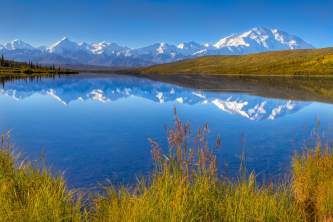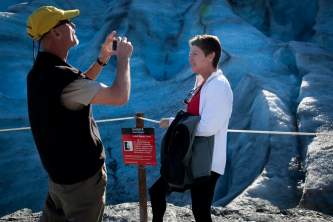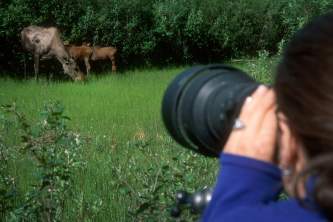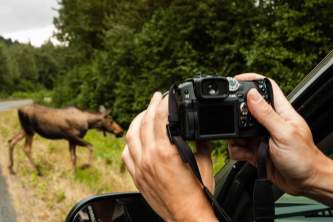Alaska Photography: What's Different
With huge landscapes, darting wildlife and light bouncing off both ice and water, Alaska is a feast—and a challenge—for any level of photographer. Here are some tips to get the most out of your camera in Alaska:
Use A Telephoto Lens For Wildlife
You'll need a 180mm or longer lens to bring moose and bear in close while keeping a safe distance. Eagles and birds generally require even longer lenses—300mm or more. Remember, longer lenses magnify lens shake and can blur images at low shutter speeds. Use a shutter speed equal to or faster than the inverse of the lens' focal length (e.g. for a 200mm lens, shoot at 1/200th sec or faster).
Lighting Can Be Tricky
That's especially so when you're photographing glaciers or snowy mountainsides. Bright snow tricks your camera into believing there's more light than there really is. If your camera has an exposure compensation meter, overexpose by 2/3rds or a full stop or alternately, take exposure readings away from the snow.
Polarizing Filter
Use a polarizing filter to make colors more vibrant. Polarizing filters cut midday glare and reflections off our many lakes, rivers, and mountains. White clouds stand out more dramatically against the blue sky, foliage appears lusher, and Alaska's frequent rainbows become more vivid.
Composition Tips
Keep your horizon level, especially when shooting Alaska's oceans and mountain ranges. Don't place the horizon in the center of the frame; it usually results in a static photo. Figure out what attracted you to the photo to begin with: If it was mountains, glaciers, and sky, fill up the frame with those elements and put the horizon low. If it was tundra or rivers stretching endlessly, put the horizon high. Add something to the foreground to lead the viewer's eye through the photo, such as a boulder, river, or flower.
Photograph In The Magic Hour
Shooting just before sunrise or after sunset can result in some gorgeous photos. Alaska's long days and lingering sunsets bathe the landscape in natural colors seen few other places. Underexposing by a half-stop saturates the colors and helps you capture the beauty of Alaska to take home memories that will last a lifetime.




